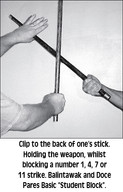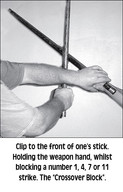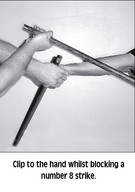Russell Balintawak Empty or Livehand – Part 3
- John Russell
- Jan 30, 2015
- 4 min read

An edited version of this Article was first published in Rapid Journal within the Philippines in 2007 under the Title of: The Importance of the Empty-Livehand of Arnis/Escrima.
Importance of Clipping Demonstrated
The importance of clipping was illustrated to me on several occasions.
One was when I was training with a student from another Grouped Balintawak school, while I was the attacker or leader. In defence, he did not clip at all. This allowed me to easily move and redirect my weapon, (after the initial contact with his blocking weapon), less than an inch around and under his emptyhand to strike him. This redirect counter while not a full power strike, would enable me to set the student/opponent up, for the powerful finishing off strike to the head, that I would deliver while the student is in pain and distracted into not defending properly.
I redirected my counter several times and after we had played for a little longer, I asked him, “Why didn’t you clip?” He said to me, “We do not clip for at least a year and are then taught to clip. It is more the flow that our instructor wants.” This guy however, had been training with his instructor for over five years.
To me in Balintawak, the flow comes from the student doing their defensive and attacking moves properly, not letting someone get away with an attack and redirect counter by not clipping, ALL THE TIME. With clipping an attacker cannot redirect. The attacker must pull the stick back out of the defenders grip, to again properly strike the student. This is not fast and pretty however.
“If you can’t learn to fight in a year, go and buy a gun. Something or someone is holding you back. Either it is yourself or your instructor.” Floro “Popoy” Quebec
This statement from the student disappointed me. Learning A/E for one year (or longer) and then throwing those years of training away to then learn something new, is like learning boxing for a year, then having your coach say, “Throw what you have been taught away, now we are going to show you the real way to box.”
One of my instructors of A/E from Leyte and one of the best friends I have ever had, not Balintawak but a Serrada–Sumbrada instructor, Floro “Popoy” Quebec, a former Manila Cop, then a Malacañang security officer, then an Los Angeles City Cop (U.S.A.), always said to me, “If you can’t learn to fight in a year, go and buy a gun. Something or someone is holding you back. Either it is yourself or your instructor.” Is this what is happening here?
The other two incidents that showed me the importance of clipping/controlling in Arnis/Escrima, were in 1992, when I was with Henry Jayme, my major Balintawak Instructor. Henry was at one time training with Grandmaster Victor Cagadas of the Doce Pares and then at another time training with an Instructor of an original un–grouped Balintawak school, down near the Cebu port area.

With Victor, it was a typical hot and humid training afternoon at his small home/tailor shop in one of the slum areas near T. Padilla Street. Four to five students were nervously sitting and sweating on seats and benches around the walls in his small living room. Victor and another student (Henry) were training, whilst a crowd had come to view the action with the strange yellow haired foreigner (me). Henry and Victor were enjoying a little free play until Victor yelled at Henry to “Stop controlling my stick”, as what seemed to me, Henry was getting the better. Henry yelled back “But you’ve taught me to control your stick, otherwise you’ll hit me” to which Victor subsequently did.
The other, later incident in 1992, was in a downtown original ungrouped Balintawak school. I had been seen in Cebu City with a Teovil’s Balintawak t–shirt (original Teovil’s, the Teofilo Velez school).
A nice gentleman introduced himself as a student of this original un–grouped Balintawak school and I was invited to see their training. I asked Henry to come along. After about 1 hour of Balintawak training, with different people taking the lead to attack or feed (agak); while the other person would defend counter, Henry and their instructor began to train, which again turned into a freewheeling or free play.
Similar to the time with Victor, the Balintawak instructor said to Henry to stop controlling his stick. Henry said back, “Why? You are trying to control mine, so I am trying to control yours. It’s all even.”
The free play ended with Henry snaking (snatching/disarming) the instructors stick away whilst simultaneously striking to the head. To which the original Balintawak Instructor had said previously in the night to me, “A snake disarm would never work against a Balintawak practicioner”.
This brought me to the philosophy of “If you don’t continually practice the disarm and hence the defense to the disarm, the disarm will work”.
No Clipping Results In: The Flow?
Another reason that some instructors of Balintawak and even other A/E styles like the flow that is generated with no clipping is that these flows are great for partner demonstrations. Not fighting or combat training but impressive moves in a demonstration.
In real fighting (if you are attacked), you grab the weapon or arm, the torso, the shoulder or the head of the opponent. If you have grabbed the weapon or weapon arm, you try to immobilise it, stun the attacker to make them more pliable (this may knock the opponent down), get rid of the weapon (disarm), finish the guy off (if he continues to attack, by knocking him down), then get the hell out ofthere before his friends or the authorities arrive.
It’s simply: cover up, grab if you can, push, shove, most importantly, hit to the head and finish. Sometimes with skill but always with heart.
Part 4 coming up….

































Comments